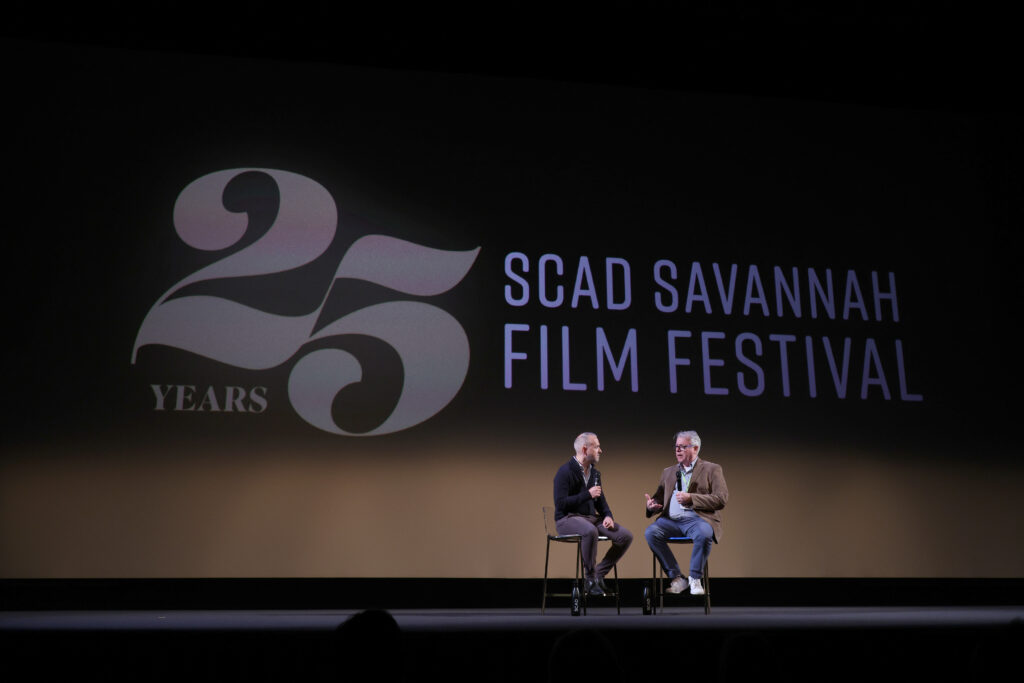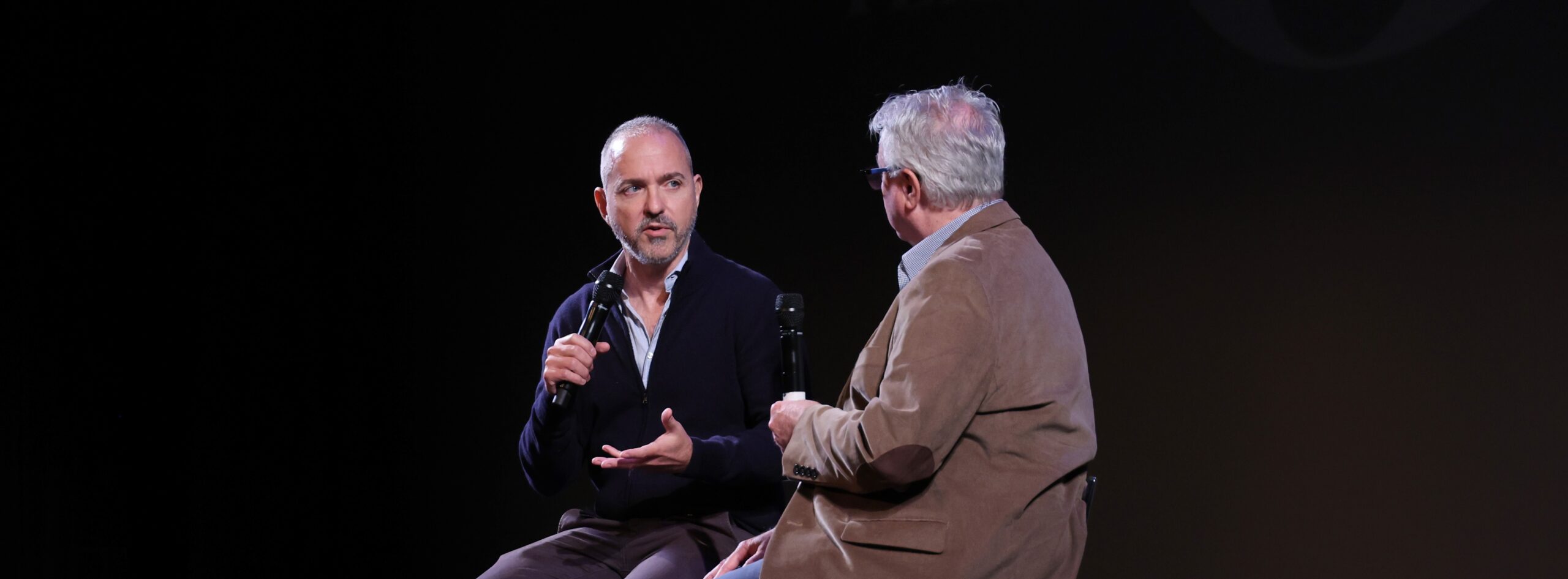SCAD Savannah Film Festival: Kyle Balda, Director of Minions: The Rise of Gru
Animation director Kyle Balda has directed movies such as Bug’s Life, Toy Story 2, Monsters Inc, Minions, Despicable Me 3, and many more. He was at the SCAD Savannah Film Festival this week to talk about his work on Minions: Rise of Gru. After the screening of the movie this past Tuesday, Kyle Balda talked about his work on the film and his backstory during the Q&A portion of the event.

When we’re talking about doing a sequel, what’s the inspiration for the backstory?
We knew the way that we left off Minions, that there was a story to tell with Minions in Gru’s relationship. That first film was set in the 60s, and this newest one was set in the 70s. One of the original inspirations came from Brian Lynch, the writer of Minions. In terms of an idea, like a genre film, like a company. So there was this idea about what was their relationship with Gru growing up. How he comes to be with them up to that story from his adult life. A lot of it was thought it almost as a romantic comedy. For example, they come together, break up, and come back together. We’re trying to tell the story in that way.
How is it working with the voice actors?
For example, getting the Minion’s voices. That’s something quite unique from working with Steve Carell, where you only get a voice session maybe every two months or so. But with Pierre, we would have him help with storyboards, try some stuff out, get it together quickly, and then he would do the voices correctly, which would inspire the storyboard artists in turn.
What happens when voice actors have to go home?
We would have multiple sessions. Almost even at the very end, there’s some ADR that happens. If an idea came in, you just put a pin in that shot for the next time the voice actors come back. And in a very, very rare case, we would animate from scratch and have the voice actors speak over that. But an interesting thing about working with voice talent is you want to let them be the custodian of that character. So many of the gems of Steve Carrel are just from him coming right off the cuff.
Allan Arkan was fun to work with. We were always asking him to yell. Part of it is because there’s something that happens with talking into the mic where you naturally start talking a little bit more quietly because the microphone is doing the work. But you want to get that projection from the characters. So that tends to be one of the most common notes is loudness. He would start coughing like, “you’re gonna kill me with this”. But I got a nice message from him at the end of the movie saying that he saw it and that it was good he spoke louder.
How do you start formulating a story from the beginning?
It’s very organic. I think this is very true for most of our studio animation films. We don’t start with a finished script: we start with more of a concept. Then you start optimizing things, and there become some obvious choices of sequences that can be written. In some cases, there are sequences that are really purely about action, and we’ll get the beat board’s worked out for those. So it really depends on the nature of what’s in the sequences. The writer’s with us; we’re all together. Or even in some cases, we’re together on the phone, talking overseas between Paris and Los Angeles. And it’s very crowded in a sense. Sometimes we’ll get a written sequence for a storyboard artist to board. Occasionally, they’ll be like a more action-heavy scene where the storyboard artist and the director will work that out, and then the writer will do a pass to provide some dialogue and more structure.
Were there any new scenes that you threw out?
Yeah, that happens quite a bit, as you’re finding. But I found that storyboarding helps a lot with providing some quick “retakes”. It provides some scratch scenes and dialogue that we can look through to get a rhythm for it to see if it’s working or not. Sometimes you hear films being storyboarded 8 times.
Can you compare what you do as an animation director to what a live-action director does?
My favorite comparison is like a band doing a live concert versus a band that’s doing a studio recording. Where live-action directors are the live band and animation directors are the bands recording in the studio. As a live-action director, you can go in and do some tweaks, but you really have to make sure that you’ve got it before you break down the set. Whereas animation is wildly forgiving, you’re constantly tweaking, turning knobs, and dialing things. There’s a lot more control.
Now, obviously, you’re a director, and you’re at the top of the pyramid, which is great, but it didn’t start that way. Could you tell us a little bit about how you got to where you are now?
Like probably a lot of people here today, I was drawing. But I never thought about animation as a real career path because where I grew up, in Tucson, Arizona, animation didn’t seem possible. And then it was really just a stroke of luck through one of my cousins; they said there was a friend of our family as a Disney animator who had just finished doing all the animation for Sebastian, the crab in Ariel. He really took me under his wing. I always thought I wanted to be a graphic artist, so I had sketchbooks. He looked at them and gave me structure. He said you’re drawing like an illustrator. I was drawing defined things, but I needed to draw motion and gestures. And he was like, “you know, you really should go to CalArts.” I was just really lucky because I went to a very expensive school, and my parents kind of understood what I wanted to do. I think my father was a little bit skeptical.
But then I did an internship at LucasArts, and they were doing video games at the time. But across the parking lot, they were starting to make Jurassic Park. When I came back to school, I kind of got the 3D animation bug because ILM donated some computers to CalArts. And I submitted my work to get into this program. But the interesting thing is that there wasn’t a really solid program to teach this methodology for 3D animation. So I spent a lot of time on putting textures on faces and things like that that a lot of people did, especially back in the day because you don’t know how to start moving things.
Jurassic Park came out that summer, so ILM was suddenly hiring tons of people. They were able to bring me in, and it’s funny because they said, you know, we’re not hiring you because of that 3D animation that you did; we’re hiring you because we found your hand-drawn animation showed a lot of storytelling and acting. And that’s really what you’re doing; you’re using the software and tools, but in the end, it’s the story and performance that matters.
The industry was growing so quickly. Then Jumanji started; I was 20, and I was already a supervisor. Because everybody who was senior to me and other supervisors were on other films that were happening at the time. But from there, I went to Pixar for three, four, or five years. And then, at that point, I was kind of considered crazy because I just wanted to teach in Europe. It was harder than I thought it was, in a good way. I got the suburban experience and had a really great time teaching. I had been living in Paris for maybe five years.
I don’t know how many people in the crowd are in computer animation, but there is an instrument called the graph editor, which shows lines that are representative of the character’s movement. I was teaching once, and one of my students asked me to look at their animation, and they showed me the graph editor instead of showing me the animation. I was terrified because it’s like driving, but you’re looking at the speedometer to drive instead of out the windshield.
This movie had such amazing and dynamic actors that truly embodied the character and made the movie come alive. So my question would be, what do you look for in actors you’re casting for?
First, think about who the character is. The majority of an actor’s body of work is to get accurate, which shows that they can embody that character and they can really bring that forward. Sometimes with actors we already know, we can look at their previous work and compare them to characters we want them to act for. Or, in the case of a new actor, we’ll get a bunch of recordings from them, and then we’ll listen to it against either some artwork of the character or a few examples of the model. Occasionally, we’ll go as far as doing animation tests with one character to have an actor speak from. But the truth of it is, is that once we can see, I can start working with them. And once you get across, I think there’s so much of an actor’s DNA and groove in that character that it’s for me they’re all the same person. So there’s a big influence there as well.
If you haven’t already seen Minions: The Rise of Gru, I would highly recommend it. As someone who has never really liked the Minions in general, I have to say this movie converted me. The animation, renderings, storyline, and characters are what makes the movie fun and heartwarming to watch. You can watch this movie on Amazon Prime or Apple TV.
